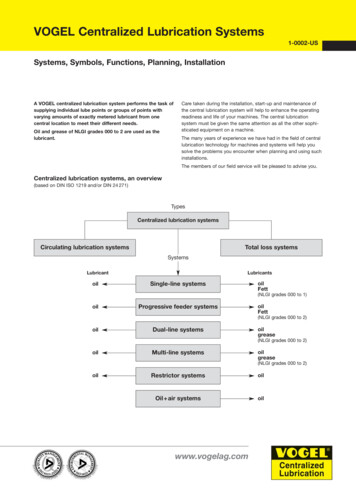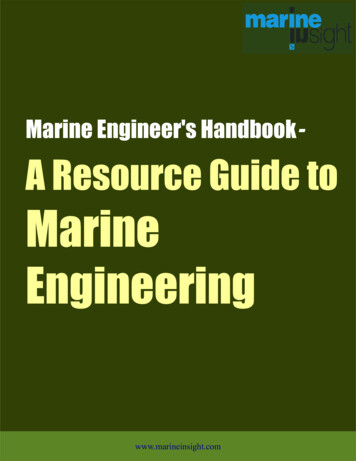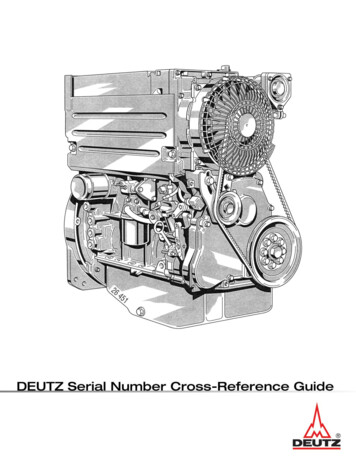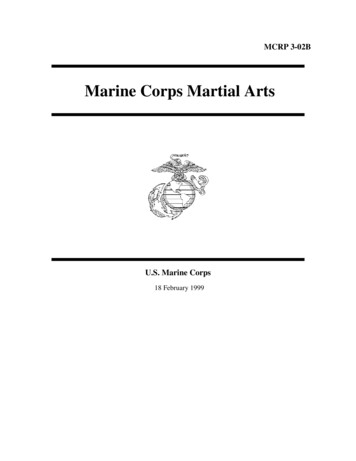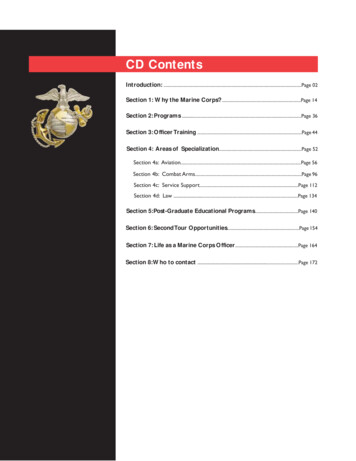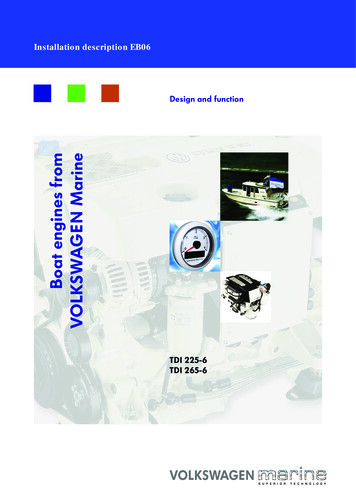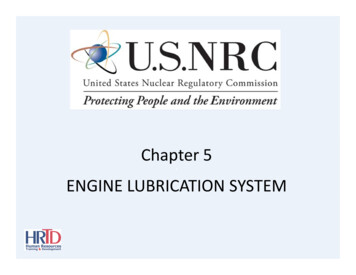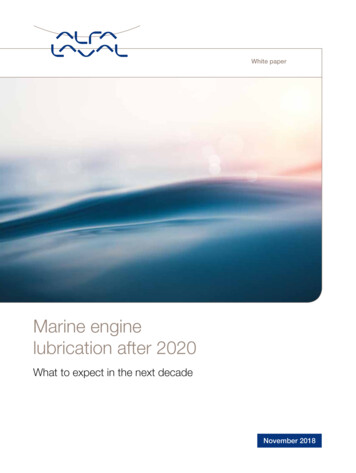
Transcription
White paperMarine enginelubrication after 2020What to expect in the next decadeNovember 2018
ContentsIntroduction.3Fuel oil regulations and their impact on marine engine lubrication.4Slow-speed engine system oils (2-stroke, crosshead) .5Medium-speed engine lubricants (4-stroke, trunk) .51. ULSFO (0.10% S).72. VLSFO (0.50% S).73. HSFO (3.50% S or more) with exhaust gas cleaning .74. Gaseous Fuel (0.0% S).85. Biofuel (0.0% S).8Requirements for engine oil treatment systems.9Lube oil cleaning.11What to expect in the next decade.16Loss prevention essentials.17Bibliography.18Alfa Laval white paper2
IntroductionAccording to The Swedish Club, main engine damage accounts for28% of all machinery claims and 34% of the costs, with an averageclaim cost close to USD 650,000. Lubrication (lube) oil failure is themost expensive and frequent cause of damage, followed by incorrectmaintenance and poor fuel management. (The Swedish Club, 2018)Improper lube oil management combined with abrasive particlecontamination is the major cause of damage. Therefore, efficientoil cleaning is essential to minimize the risk for engine wear anddamage.Alfa Laval white paper3
Fuel oil regulations and theirimpact on marine enginelubricationForthcoming regulations for the global use of marine fuel oils withsulphur content no greater than 0.5% are causing marine lubricantoil and engine manufacturers to reassess the lubrication characteristics/requirements of their products. The reduction of sulphur contentfrom 3.5% to 0.5% in 2020 will require a reformulation of marinefuels. It is likely that a higher percentage of cat fine-containing cutterstocks will be used to reach the lower sulphur levels.Without proper fuel treatment, the higher content of cat-fines willincrease the wear of fuel injection systems, cylinder liners and pistonrings, leading to further soot accumulation in the cylinders and in thelube oil. In addition, abrasive catalytic (cat) fines can migrate into thelube oil via piston rings blow-by.*The following section discuss the possible impact IMO 2020 regulations will have on the two marine engine lubrication systems.* Cat fines are the most abrasive of all substances in heavy fuel oil. These arefragments of a catalyst added to the oil in the refining process. Composed ofsolid particles of aluminum and silicon compounds, catalytic fines are almostas hard as diamond and vary in size from sub-micron to approximately 50 µm.Alfa Laval white paper4
Slow-speed engine system oils(2-stroke, crosshead)Because of the crosshead engine design, the system oil will remainrelatively unchanged following IMO 2020 limiting HFO to 0.5%S.However, the cleanliness of the piston ring pack of engines runningon this fuel will still require a lubricant with a high detergency level.(CIMAC, 2014)Medium-speed engine lubricants(4-stroke, trunk)Unlike the system oil in a crosshead diesel engine, crankcase lube oilin a medium-speed, 4-stroke, trunk marine engine is continuouslyexposed to combustion products.However, the lubricant approach for these engines will not besignificantly different from the lubricants used today with fuel oils thatpossess an average sulphur content of about 2.5%(S). Although0.5%S is a lower sulphur level present than in the majority of residualfuels currently used, it is still a significant quantity, requiring asufficient BN to neutralize the acidic combustion by-products.In most cases, it is probable that the content of residual components(like asphaltenes) will be lower than in today’s heavy fuel oils;however, a good level of asphaltene dispersancy will still be required.Current commercial products are able to fulfil the lubricationrequirements, and a shift towards lower BN (e.g. 12-40 instead of30-40) and very high BN (e.g. 50 or 55) is unlikely. (CIMAC, 2014)The lube oil acts as transport medium for insolubles produced in theengine. The degree of engine fouling is determined by theconcentration of insolubles and the tendency of the oil to leavedeposits. (CIMAC, 2004)Under normal oil consumption conditions, trunk piston engine oils donot require complete oil changes for up to several years, providedcombustion conditions remain normal and is the oil not diluted byraw residual fuel contamination. (CIMAC, 2004)For the reasons above, trunk piston engines burning residual fuelsare best fitted with continuously running centrifuge purifiers/separators of sufficient capacity, cleaning their lubricating oil byremoving water, soot and other contaminants.Alfa Laval white paper5
Based on current regulations for the use of low-sulphur marine fueloils, and upcoming initiatives for reducing greenhouse gas (GHG)emissions in the marine industry, it is likely that the following marinefuels will coexist in the coming decade. Ultra-low sulphur fuel oil (ULSFO) – can be MGO (distillate) orresidual-based (IMO 2015) Very low-sulphur fuel oil (VLSFO) – probably will beresidual-based (IMO 2020) High-sulphur fuel oil (HSFO) – used in combination with exhaustgas cleaning (i.e. scrubber) Gas – liquid natural gas (LNG) or liquified petroleum gas (LPG) Biofuel – hydrogenated vegetable oil (HVO) or fatty acid methylesters (FAME)How each of these fuels might impact the lube oil is discussed in thefollowing sections.Note: This document focuses on medium-speed trunk engine lubrication systemsversus low-speed crosshead engine lubrication systems, which isolate thecombustion chamber from the fuel oil.Alfa Laval white paper6
1. ULSFO (0.10% S)This fuel oil became the prevalent fuel in ECAs as of January 2015.Within the ULSFO fuel market, marine gas oil (MGO) dominates;however, an increasing number of residual-based and cat finecontaining fuels are becoming more common.Impact on engine lubricantThe use of this cleaner fuel will result in lower contamination of thelubricant, offering the possibility to optimize and adapt the oil systemto this lower contamination. Smaller oil volumes, lower oilconsumption and less effort for cleaning the oil are options arisingfrom this fuel type. (CIMAC, 2014)2. VLSFO (0.50% S)This fuel type will likely dominate the market in 2020 followingenforcement of the IMO legislation – derived from heavy fuel oil(HFO) refinery streams, bringing the combined sulphur level as closeto the 0.50% S limit as possible.Depending on supply sources, there will be a wide range of differentviscosities and densities available. Likewise, its combustion qualitiescould vary greatly. Finally, being residual-based, this fuel oil willcontain similar or even higher catalytic (cat) fine contents (aluminiumand silicon particles) as can be found today.Impact on engine lubricationThis fuel will require a lube oil that can handle moderate asphaltenelevels and possess an adjusted base number (BN) to handle thesulphur oxidation products. It is expected the lubricant BN will be 20to 30 (mg KOH/g). (CIMAC, 2008)3. HSFO (3.50% S or more)with exhaust gas cleaningThe use of this high sulphur fuel oil (3.50% S) is acceptable whenexhaust gas cleaning equipment (i.e. scrubber) is used – providedstack emissions (SOx) levels are equivalent to or less than thoseproduced by fuels stipulated by global and ECA caps.Impact on engine lubricationUsing this fuel, today’s lube oil will to great extent remain unaffected.However, many modern engines are designed for low-lube-oilconsumption, which requires the use of high BN lubricants (50 mgKOH/g or even higher) and/or shorter intervals between oil changes.(CIMAC, 2008)Alfa Laval white paper7
4. Gaseous Fuel (0.0% S)Liquified Natural Gas (LNG) and Liquified Petroleum Gas (LPG) asmarine fuels are receiving increased interest due to their currentlylow price and compliance with IMO emissions limits with respect toboth SOx and NOx. LNG contains virtually no sulphur and,depending on the marine engine type, produces low NOx.Impact on engine lubricationThis fuel contains 0.0%S and produces low ash. By using thiscleaner fuel, smaller oil volumes, lower oil consumption and less oilcleaning effort are required compared to HFO-operated enginestoday. (CIMAC, 2014)It is not fully understood whether LNG-fuelled engines may producesmaller soot particles, which may be harder to remove by oiltreatment systems.However, lube oil treatment systems will still need to remove waterand oxidation contaminants, as well as engine wear particles, fromthe engine.5. Biofuel (0.0% S)Biofuel or biodiesel are fuels derived from vegetable oils (e.g. palmoil, soybean oil, rapeseed oil), animal fats (e.g. tallow oil) and wasteorganic compounds. Most common biofuel types include Fatty AcidMethyl Esters (FAME), ethanol and Hydrotreated Vegetable Oil (HVO).Except for vessels transporting such cargoes, 100% unprocessedbiofuels are unlikely to be used in marine application. These fuelshave almost zero sulphur but can have a high acid number (low pH)which can impact fuel delivery systems.Under current supply logistics, the practice of blending FAME intoother distillate fuels is relatively common; this nearly guarantees thatsome distillate fuels supplied in the marine market contain FAME.(Chevron Marine Products LLC, 2012) The international marine fuelstandard ISO 8217:2017 allows up to 7% addition of FAME to certaindistillate marine fuel grades.Impact on engine lubricationFAME-based biofuels have a higher flash point and oxygen contentthan petroleum-based fuels. These negatively affect combustionleading to quicker accumulation of unspent biofuel in the lube oil. Tocompensate, biofuel is often diluted, which can negatively affect lubeoil. (CIMAC, 2014)Alfa Laval white paper8
Requirements for engineoil treatment systemsWhen marine fuel burns, sulphur is converted into sulphur oxides(SOx). These oxides reach the engine lube oil via the blow-by gas.These oxides are corrosive to engine piston liners and must beneutralized by the engine lubricant. Marine engine lubricants aredeveloped to cope with this acidity (high BN). (Chevron MarineProducts LLC, 2012)Diesel engines require a lube oil with a variety of properties. Not onlymust the lube oil neutralize the fuel acidity, it must be capable ofcleaning (and keeping clean) engine components, dissipating engineheat, and protecting against rust and corrosion. Moreover, it mustperform these actions for extended periods.The efficiency of a lubrication system and its oil is subject to severalstresses; proper monitoring, maintenance and replacing the oilensures its proper function.The following are the principal functions of lube oil: Reduce friction leading to engine component wear Minimize rust by removing oxidation particles Cool by removing heat Protect engine components against harmful deposits Seal engine compartmentLube oil also helps keep deposits from forming throughout the entirelubrication system, including circulation lines, check valves and sightglasses. With fresh and clean lube oil in the system, marine engineperformance and efficiency can be optimized.Unfortunately, even under optimal engine operation, lube oilbecomes contaminated. This is the result of a) accumulation ofcontaminants, including combustion soot, acidic combustionblow-by products, raw residual fuel and water, and b) the influence ofhigh temperature, aeration and NOx.Alfa Laval white paper9
Contamination has costly consequences to marine engines: Chemical degradation (reduced BN) Corrosion Increased oil consumption Friction (evidenced by wear and noise) Efficiency losses Clogging Engine failureWith regular checks, oil deterioration can be detected in time; it isrecommended to send samples to a laboratory to make the relatedanalysis. The following table displays alerts and condemnation limitsfor important lube oil properties:ParameterAlert limitCondemnation limitUnitTest methodViscosity at 40 CMaximum 140Maximum 150mm2/s (cSt)ASTM D 445Flash pointMinimum 200Minimum 180 CASTM D 92/93Total insoluble materialMaximum 0.7Maximum 1.0% m/m 1ASTM D 893bBase number (BN)Maximum 12Maximum 15mg KOH/gASTM D 2896Water contentMaximum 0.20Maximum 0.30% m/mASTM D 95 orASTM D 1744Strong Acid Number (SAN)0.0Maximum 0.0mg KOH/gASTM D 664Calcium–Maximum 6 000mg/kg (ppm)ICPZinc–Minimum 100mg/kg (ppm)ICPPhosphorus–Minimum 100mg/kg (ppm)ICPFZG gear oil set 2Minimum failureload stage (FLS) 9Minimum failure load–stage (FLS) 8A/8. 3/90(ISO 14635-1)1% m/m means by mass, e.g. a water conent of 0.20% m/m means that thewater content is 0.20% of the mass of the total solution.2To do the FZG gear oil test is recommended one time each year.NOTE: Use these limits as a guide. You cannot make an estimate of the system oilby one parameter. Get also other oil parameters to find the causes of problems.(Source: Lubricants: All Engines, WinGD, Issue 001 2018-02)Alfa Laval white paper10
Lube oil cleaningThe main reason for continuous cleaning of the circulating lube oilis to maintain lube oil performance by removing contamination (dirt,insoluble combustion products and water).Filters integrated in the system retain residues (particles) from beingtransferred back to the engine, potentially damaging it. Whereas,separators/centrifuges installed in bypass to the main lube oil servicesystem of the engine remove combustion residues, water and othersmaller mechanical contaminants.Function of centrifugal separatorsA centrifugal separator uses centrifugal force to remove particles andwater from lube oil in a single operation. The contaminants – in theform of sludge and water – are forced outwards, while clean lube oilis continuously transferred back into the engine.The level of contaminants on the lube oil system depends mainly onthe output and type of engine and type of fuel. In addition to particlecontent, particle size has strong impact on the separation efficiency.Different engine types and fuel types can generate different sizeranges for the soot particles.Alfa Laval white paper11
The increasing difference in density between water and lube oil withincreasing temperature is the basis for centrifugal cleaning (purification). Cleaned oil and separated water are continuously dischargedduring operation.Parameters affecting separation efficiencySeparation efficiency is dependent upon including temperature (controlling both lubricating oil viscosity and density), flow rate, particlesize and proper separator care and maintenance. A separator’sability to separate contamination from lube oil is regulated by Stoke’sLaw (see equation below).vc d2 ( ρP – ρLO)18ƞω2rSettling velocity (vc) depends on:Particle size, dParticle density, ρPLube oil density, ρLODynamic viscosity of lube oil, ƞCentrifugal acceleration, ωParticle position on circular radius, rDensity and viscosityThe greater the difference in density between the contaminationparticles and the lubricating oil, the higher separation efficiency. Thesettling velocity increases in inverse proportion to viscosity. However,since both density and viscosity vary with temperature, separationtemperature is the critical operating parameter.TemperatureTo ensure centrifugal forces are able to separate the heavy contaminants in the relatively limited time that they are present in theseparator, oil entering the separator unit needs to be heated. An inlettemperature of 90 C or 95 C with only small variations (maximum 2 C) is recommended for lube oils.Alfa Laval white paper12
Particle sizeThe settling velocity increases rapidly with particle size. Typically,this means the smaller the particles the more challenging the taskof separation. However, in a centrifuge, centrifugal force enables theefficient separation of particles which are only a few microns in size.Separation efficiency -Particle sizeDensity differenceViscosityFlowrateOperation and design flow ratesSeparation efficiency is a function of the separator flow rate (i.e.operation flow) – the higher the flow the less efficient separationbecomes and, conversely. As flow rate decreases, particle separation increases (Stoke’s Law). The required flow needs to reflect thequantity of contaminants entering the system and the separator’scontinuous operation time.To ensure optimum cleaning of the lubricating oil, the separator ratingshould be higher than the design flow rate (Q) as calculated by thefollowing equation:QLO P V ntQLO: Required design flow [ L h-1 ]P: MCR (Maximum Continuous Rating) in [KW]V: Nominal system oil volume equal to 1.36 [ L KW-1 ]n: Number of separation passes per dayt: Effective run time: 23.5 hThe required number of passes (n) varies by fuel type and enginemanufacturer. MAN recommends n(HFO) 7, n(MGO/MDO) 5 andn(dual fuel engines with LNG/LPG) 5. (MAN Diesel & Turbo, 2016).Wärtsilä recommends n(HFO) 5 and n(MDO) 4. (Wärtsilä, 2018).Alfa Laval white paper13
Water in oilWater in oil tends to wash the oil film off the cylinder walls and cancontribute to corrosion by reacting with the sulphuric acid derivedfrom the combustion of the fuel sulphur. (CIMAC, 2008)Furthermore, middle alkaline lubricants can form water-in-oil emulsions which can be difficult to remove. Such emulsions, if circulated,will reduce the load carrying capacity of the oil in bearings, possiblyleading to failures. Emulsified oil, therefore, should be replaced assoon as possible. (CIMAC, 2008)Detergents and dispersants in oilDetergents and dispersants are commonly added to lube oils to suspend soot and prevent formation of larger particle agglomerates, andto keep polar compounds in solution. However, these additives alsoprevent the separator from performing at its best.A recent test performed by Chevron confirms the importance ofseparators for reducing soot build-up in lube oil. Without purification,oil viscosity sharply increased, requiring shorter intervals between oilreplacement. However, when a lube oil separator was used, insoluble soot levels remained constant over a long period, significantlyincreasing the service life of the engine oil.10.9Insoluble (soot) level / 00014000Oil Sevice HoursDelo SHP operation without purifierDelo SHP operation with purifierImpact of purification on soot load in medium speed engines (Source: Chevron Lubricants).Alfa Laval white paper14
Benefits with separatorsCentrifugal separators are known for their highly efficient cleaningabilities, consistent and reliable performance, and minimal maintenance and attendance requirements.Moreover, integrating a centrifugal separator is simple process,because no modifications are necessary to existing systems. Theseparator module is installed in a bypass loop, separate from engineoperation.Lube oil centrifugation benefits are numerous: Solids and water removal in a single operation Highly effective cleaning ability, down to small particle sizes Large-volume cleaning Minimal service and maintenance requirements Prolonged engine lifetime Lower operational expenses (OPEX) compared to cartridge filtersAlfa Laval white paper15
What to expect in thenext decadeThe 2020 regulations will cause more changes to global marineindustry than did the 2015 regulation to use 0.10% S in only certainareas; the impact of this transition will affect approximately 75% oftotal global marine fuel usage.There are still numerous unanswered questions regarding the impact the2020 IMO regulations will have on marine engine lubrication systems.Evidence suggests that the use of a centrifugal separator, to removecontaminants (insolubles and water) from the lube oil, will continue topromote engine longevity and efficiency, regardless of the fuel oil used.Alfa Laval white paper16
Loss prevention essentialsHere is a handy checklist for avoiding main engine damage, resultingfrom lube oil failure: Implement robust onboard fuel and lubrication oil managementsystems. Check that the feed has correct flow and temperature – aseparator inlet temperature of 95 C, or 90 C for cross-headengines, is recommended. Use the separator manual to find the correct gravity disc– aim to have the gravity disc with the largest hole diameterwithout causing a break of the water seal. Keep the separator disc stack clean – use a Clean-In-Place (CIP)unit at regular intervals. Follow the separation manufacturers recommendations formaintenance intervals – periodic (preventive) maintenancereduces the risk of unexpected stoppages and breakdowns. Always use genuine replacement parts – otherwise safeoperation of the equipment is not guaranteed, and the warrantymay become invalid. In addition to onboard testing of lubrication oil, submit samplesfor laboratory analysis at regular intervals, at least every thirdmonth. Carry out drip sampling when bunkering the fuel oil – avoidconsuming the fuel until analysis results are available. Always take engine alarms seriously, for example oil mistdetection, and investigate thoroughly – a fully functional alarmsystem is essential for the safe operation of the main engine.Alfa Laval white paper17
Bibliography Chevron Marine Products LLC. 2012. Everything You Needto Know About Marine Fuels. Chevron Marine Products LLC. 2013. Information Bulletin 4:Base Number. CIMAC. 2014. Guideline by WG8, Marine Lubricants, 1st edition. CIMAC. 2013. Guideline for the Operation of Marine Engines onLow Sulphur Distillate Diesel. CIMAC. 2004. Guidelines for Diesel Engine Lubrication– Oil Degradation. CIMAC. 2008. Guidelines for the Lubrication of Medium SpeedDiesel Engines, 2nd Updated Version. MAN Diesel & Turbo. 2015. MAN L32/44 GenSet Project Guide– Marine: Four-stroke diesel enginecompliant with IMO Tier II. MAN Diesel & Turbo. 2016. Project Guide – Marine. Wärtsilä 50DF Product Guide - a19 – 25 July 2018. The Swedish Club. 2018. Main Engine Damage. WinGD. 2018. Lubricants: All engines – Issue 001.Alfa Laval white paper18
About Alfa LavalAlfa Laval is a leading global provider of specialized productsand engineering solutions.Our equipment, systems and services are dedicated to helpingcustomers to optimize the performance of their processes. Timeand time again. We help our customers to heat, cool, separate andtransport products such as oil, water, chemicals, beverages,foodstuff, starch and pharmaceuticals.Our worldwide organization works closely with customers in almost100 countries to help them stay ahead.How to contact Alfa LavalUp-to-date Alfa Laval contact details for all countries are alwaysavailable on our website at www.alfalaval.com100000909-1-EN 1811How to contact Alfa LavalContact details for all countries are continually updated on our web site.Please visit www.alfalaval.com to access the information directly.
(SOx). These oxides reach the engine lube oil via the blow-by gas. These oxides are corrosive to engine piston liners and must be neutralized by the engine lubricant. Marine engine lubricants are developed to cope with this acidity (high BN). (Chevron Marine Products LLC, 2012) Diesel engines require a lube oil with a variety of properties. Not .
